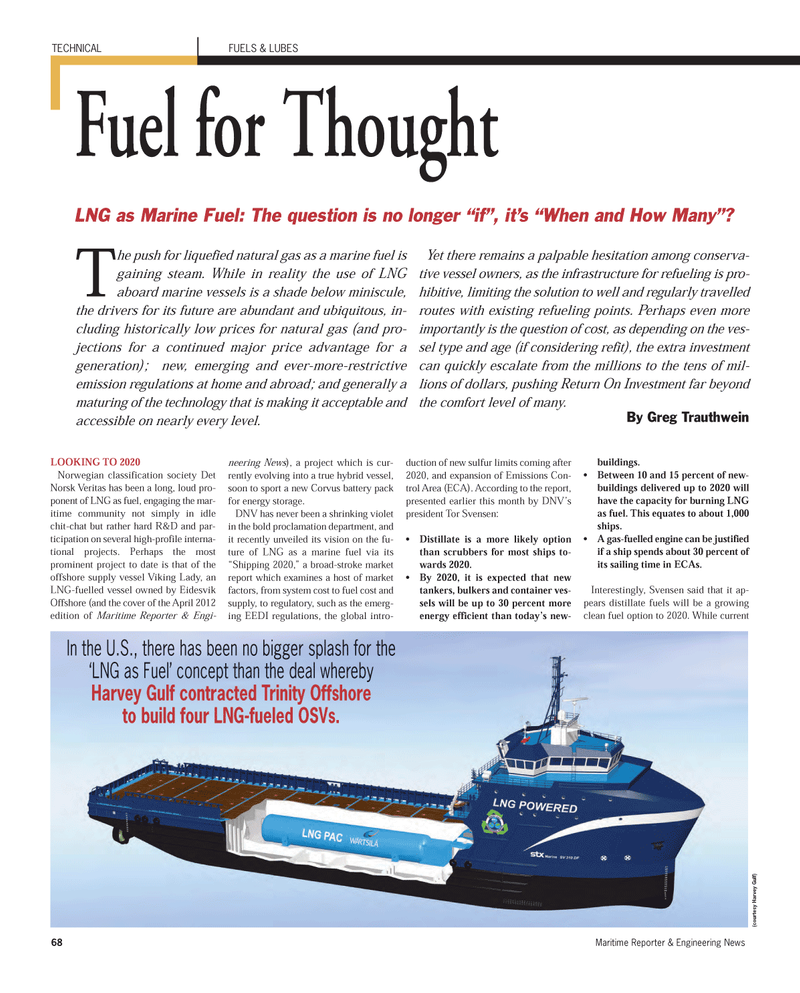
Page 68: of Maritime Reporter Magazine (June 2012)
Annual World Yearbook
Read this page in Pdf, Flash or Html5 edition of June 2012 Maritime Reporter Magazine
68Maritime Reporter & Engineering News TECHNICALFUELS & LUBESThe push for liquefied natural gas as a marine fuel is gaining steam. While in reality the use of LNG aboard marine vessels is a shade below miniscule, the drivers for its future are abundant and ubiquitous, in- cluding historically low prices for natural gas (and pro- jections for a continued major price advantage for a generation); new, emerging and ever-more-restrictive emission regulations at home and abroad; and generally a maturing of the technology that is making it acceptable and accessible on nearly every level. Yet there remains a palpable hesitation among conserva- tive vessel owners, as the infrastructure for refueling is pro- hibitive, limiting the solution to well and regularly travelled routes with existing refueling points. Perhaps even more importantly is the question of cost, as depending on the ves-sel type and age (if considering refit), the extra investment can quickly escalate from the millions to the tens of mil- lions of dollars, pushing Return On Investment far beyond the comfort level of many. By Greg Trauthwein LOOKING TO 2020 Norwegian classification society Det Norsk Veritas has been a long, loud pro- ponent of LNG as fuel, engaging the mar- itime community not simply in idlechit-chat but rather hard R&D and par- ticipation on several high-profile interna- tional projects. Perhaps the mostprominent project to date is that of theoffshore supply vessel Viking Lady, an LNG-fuelled vessel owned by Eidesvik Offshore (and the cover of the April 2012 edition of Maritime Reporter & Engi-neering News ), a project which is cur- rently evolving into a true hybrid vessel, soon to sport a new Corvus battery pack for energy storage. DNV has never been a shrinking violet in the bold proclamation department, andit recently unveiled its vision on the fu- ture of LNG as a marine fuel via its?Shipping 2020,? a broad-stroke market report which examines a host of market factors, from system cost to fuel cost and supply, to regulatory, such as the emerg- ing EEDI regulations, the global intro- duction of new sulfur limits coming after 2020, and expansion of Emissions Con- trol Area (ECA). According to the report, presented earlier this month by DNV?s president Tor Svensen: Distillate is a more likely option than scrubbers for most ships to- wards 2020. By 2020, it is expected that new tankers, bulkers and container ves- sels will be up to 30 percent more energy efficient than today?s new- buildings. Between 10 and 15 percent of new- buildings delivered up to 2020 will have the capacity for burning LNG as fuel. This equates to about 1,000 ships. A gas-fuelled engine can be justified if a ship spends about 30 percent of its sailing time in ECAs. Interestingly, Svensen said that it ap- pears distillate fuels will be a growing clean fuel option to 2020. While current Fuel for Thought LNG as Marine Fuel: The question is no longer ?if?, it?s ?When and How Many?? (courtesy Harvey Gulf) In the U.S., there has been no bigger splash for the ?LNG as Fuel? concept than the deal whereby Harvey Gulf contracted Trinity Offshore to build four LNG-fueled OSVs.MR June12 # 9 (65-73):MR Template 6/12/2012 3:26 PM Page 68

 67
67

 69
69
